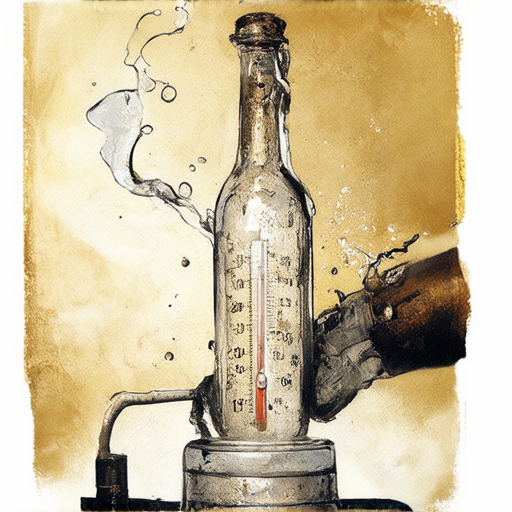When it comes to enjoying a perfectly crafted pint of beer, one crucial aspect often goes unnoticed – carbonation. But what exactly does it mean for beer to be high in carbonation? And how can homebrewers and commercial breweries alike measure and manage CO2 levels to achieve the perfect balance of fizz and flavor? In this comprehensive guide, we’ll delve into the world of beer carbonation, exploring its importance, the science behind it, and the tools and techniques needed to get it just right.
From understanding whether beer is naturally carbonated to calculating CO2 volumes and troubleshooting common issues, we’ll cover it all. Whether you’re a seasoned brewer or just starting out, this guide will provide you with the knowledge and confidence to take your beer carbonation skills to the next level. So let’s dive in and discover the art of mastering carbonation in beer.

Is Beer High in Carbonation?
Beer carbonation refers to the presence of dissolved carbon dioxide gas within the beverage. The level of carbonation can vary significantly depending on factors such as brewing techniques, yeast strains, and storage conditions.
Factors Affecting Beer Carbonation
- Understanding Carbonation Volumes: The amount of carbonation in beer is measured in volumes, typically ranging from 2 to 5 volumes. A volume represents one liter of air containing one gram of carbon dioxide. Therefore, a liter of beer usually contains between 4 to 10 grams of CO2.
- Factors Influencing Carbonation: Several factors contribute to the carbonation levels in beer:
- Brewing Techniques: Different brewing methods, such as bottom fermentation or top fermentation, can affect the final carbonation levels.
- Yeast Strains: Yeast types and strains can influence the production of carbon dioxide during fermentation.
- Storage Conditions: Temperature, light exposure, and packaging materials can impact the rate of carbonation loss over time.
Types of Beers with Higher Carbonation
Certain beer styles tend to have higher carbonation levels due to their brewing processes:
- Lagers: Typically have lower carbonation levels compared to ales, often ranging from 2 to 3 volumes.
- Ales: Can exhibit a wider range of carbonation levels, from 3 to 5 volumes, depending on the specific style.
- Sour Beers: May have higher carbonation levels due to the use of wild yeast or bacteria during fermentation.
Health Implications of Carbonation
While moderate consumption of carbonated beverages is generally considered safe, excessive carbonation can lead to:
- Gas and Bloating: Swallowing large amounts of carbonated drinks can cause discomfort and digestive issues.
- Tooth Decay: The acidity in carbonated beverages can weaken tooth enamel, making teeth more susceptible to decay.
Understanding the Science Behind Beer Carbonation
Beer is indeed a carbonated beverage, but its carbonation process differs significantly from that of soda.
Is Beer Carbonated Like Soda?
The Goods On Tap explores the differences between beer and soda, highlighting the unique characteristics of each.
- **Carbonation Process**: Beer gets its carbonation through a natural fermentation process, whereas soda is artificially carbonated using CO2 gas under pressure.
- During brewing, yeast ferments the sugars present in the wort, producing ethanol and carbon dioxide as byproducts.
Types of Carbonation
There are two primary types of carbonation in beer:
- **Natural Carbonation**: Some beers, particularly those brewed using traditional methods, may exhibit natural carbonation due to the fermentation process.
- **Forced Carbonation**: Most commercial beers are forced-carbonated, meaning they are infused with CO2 gas after fermentation is complete.
Factors Affecting Carbonation
Several factors influence the carbonation level in beer, including:
- Brewing Method: Traditional brewing methods tend to result in lower carbonation levels than modern, industrialized processes.
- Yeast Strains: Different yeast strains can affect the amount of carbon dioxide produced during fermentation.
- Storage Conditions: Temperature and storage conditions can impact the carbonation level over time.
Comparison to Soda
While both beer and soda are carbonated beverages, there are significant differences between them:
- Flavor Profile: Beer has a distinct flavor profile influenced by ingredients, brewing techniques, and aging processes, whereas soda tends to have a sweeter, more artificial taste.
- Nutritional Content: Beer generally contains fewer calories and less sugar than soda, although this can vary depending on the type and brand.
Regulatory Considerations
In the United States, the FDA regulates the labeling of carbonated beverages, including beer and soda. Manufacturers must comply with guidelines regarding carbonation levels, nutritional content, and ingredient disclosure.
Industry Trends
The craft brewing industry has seen a rise in demand for low- and no-carb beers, which often utilize alternative carbonation methods, such as nitrogen infusion or dry-hopping.

Naturally Carbonated Beers
Naturally carbonated beers are characterized by their unique blend of flavors and aromas, developed through various brewing methods.
Common Techniques Used for Naturally Carbonated Beers
- Keg Conditioning: This process involves transferring beer from a fermenter into a keg, where it undergoes further fermentation and carbonation.
- Bottle Conditioning: Similar to keg conditioning, bottle conditioning involves transferring beer into bottles after fermentation is complete.
- Spunding: Spunding is a technique used during the bottling process, where excess CO2 is removed from the beer to prevent over-carbonation.
Examples of Naturally Carbonated Beers
- Madeline: A Belgian-style ale brewed by Pure Project, known for its unique blend of yeast strains and natural carbonation.
- Roes Red: Another Pure Project offering, this red ale showcases the brewery’s expertise in crafting naturally carbonated beers.
- Emmeline: A sour ale brewed by Pure Project, featuring a complex blend of wild yeast and bacteria that contributes to its natural carbonation.
The Science Behind Natural Carbonation
CO2 is released from the beer through various mechanisms, including:
- Fermentation: Yeast consumes sugars during fermentation, producing CO2 as a byproduct.
- Gas exchange: As beer is transferred between containers, gas exchange occurs, allowing CO2 to escape and contribute to the beer’s carbonation.
- Pressure regulation: The pressure inside the container, whether it’s a keg or bottle, plays a crucial role in regulating the amount of CO2 released.

Tools and Equipment for Beer Carbonation
The art of beer carbonation requires the right tools and equipment to achieve the perfect level of fizz. In this section, we’ll explore the various options available for beer carbonation, including carbonation stones and tablets, kegging systems, and more.
Carbonation Stones and Tablets
One of the most popular methods of beer carbonation is using carbonation stones or tablets. But what exactly are they, and how do they work?
Kegging and Carbonation Systems
Kegging systems are another popular method of beer carbonation, offering a convenient and efficient way to carbonate beer at home or in commercial settings. In this section, we’ll delve into the world of kegging and carbonation systems.
Which Beer Has the Most Carbonation?
A question that has puzzled beer enthusiasts for centuries: which beer has the most carbonation? While there’s no definitive answer, certain beer styles are known to have higher carbonation levels than others.
- Belgian Quadrupels: These strong, dark beers typically have a high ABV (8-12%) and a rich, complex flavor profile. Due to their high sugar content and slow fermentation process, Belgian quadrupels often exhibit a high level of carbonation, ranging from 6-9 volumes per liter.
- Sour Beers: Sour beers, such as lambics and American wild ales, are brewed using wild yeast and bacteria, which can lead to a higher level of carbonation due to the natural fermentation process. These beers can range from 5-7 volumes per liter.
- Wheat Beers: Wheat beers, particularly those brewed with a high proportion of wheat, tend to have a lighter color and a crisper, more refreshing taste. Their carbonation levels can range from 4-6 volumes per liter.
- Pilsners: Pilsners, originating from the Czech Republic, are known for their golden color and crisp, dry taste. They typically have a moderate carbonation level, ranging from 3-5 volumes per liter.
- Gueuze: Gueuze, a type of sour beer, is made by blending young and old lambics. Its unique blend of flavors and high carbonation level (typically 5-7 volumes per liter) make it a sought-after brew among enthusiasts.
In terms of specific beers, some examples of highly carbonated brews include:
- Westvleteren 12 (Belgium): 8-10 volumes per liter
- Cantillon Gueuze (Belgium): 5-7 volumes per liter
- Allagash White (USA): 5-6 volumes per liter
- Sierra Nevada Pale Ale (USA): 4-5 volumes per liter
Temperature Control for Beer Carbonation
When it comes to controlling the carbonation of beer, temperature plays a crucial role.
Beer Carbonation Temperature
The ideal temperature for beer carbonation varies depending on the style of beer and the equipment used. Generally, a temperature range of 15°C to 20°C (59°F to 68°F) is recommended for most beer styles.
How to Monitor Temperature
To monitor the temperature of your beer, you can use a thermometer specifically designed for beer brewing. These thermometers are usually accurate to ±0.1°C (±0.2°F) and can be placed in the wort or the fermenter to track the temperature.
Sanitation and Cleaning for Beer Carbonation
Sanitation and cleaning are critical steps in the beer carbonation process to prevent contamination and spoilage.
Why Sanitation Matters
Sanitation is essential to prevent the growth of unwanted microorganisms that can contaminate the beer and cause off-flavors, odors, and spoilage. Regular cleaning and sanitizing of equipment and surfaces can help prevent contamination and ensure a healthy fermentation process.
How to Clean Your Equipment
Cleaning and sanitizing equipment regularly is crucial to prevent contamination and spoilage. Use a combination of hot water, soap, and sanitizer to clean equipment, and sanitize all surfaces with a solution of 1 tablespoon of unscented bleach per gallon of water.
Priming Sugar Calculator
A priming sugar calculator can help you determine the correct amount of priming sugar to add to your beer to achieve the desired level of carbonation.
Beverage Style Guide
A beverage style guide can provide you with detailed information on the characteristics, ingredients, and brewing processes of different beer styles.
Co2 Carbonation Chart
A co2 carbonation chart can help you determine the optimal CO2 levels for different beer styles and brewing processes.
Homebrew Carbonation Chart
A homebrew carbonation chart can provide you with a quick reference guide to help you determine the optimal carbonation levels for your homebrewed beers.

Common Issues with Beer Carbonation
Troubleshooting Common Problems
When it comes to beer carbonation, several issues can arise, affecting the overall quality and enjoyment of the brew.
Preventing Common Issues
Preventing common issues with beer carbonation can save brewers time and effort in the long run.
What Drink Has the Strongest Carbonation?
Carbonated beverages have become increasingly popular over the years due to their unique taste and refreshing properties. When it comes to determining which drink has the strongest carbonation, several factors come into play, including the type of beverage, its production process, and the level of carbon dioxide dissolved within.
- San Pellegrino is known for its high-carbonation levels, often exceeding 1.5 times that of regular soda.
- Perrier is another popular choice among those seeking a fizzy drink, with a typical carbonation level of around 0.9-1.2 times that of regular soda.
- Kombucha, a fermented tea drink, contains a significant amount of carbonation due to the fermentation process.
- Craft sodas have emerged as a popular choice among those seeking unique flavors and high-quality ingredients, with some brands offering extremely high levels of carbonation.

0 Comments